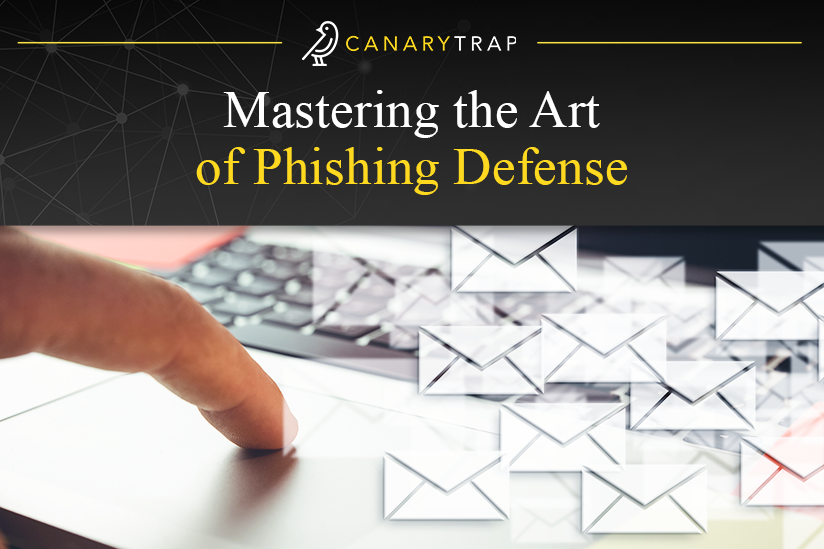Mastering the Art of Phishing Defense
- March 29, 2024
- Canary Trap
In the rapidly advancing landscape of cybersecurity, the specter of phishing attacks looms larger than ever. As a prevalent and evolving threat, phishing exploits human vulnerabilities to gain unauthorized access and extract sensitive information. In order to unravel the intricate world of phishing attacks, we need to explore their diverse forms and emphasize the critical need for robust detection and prevention strategies.
In an age where digital communication and transactions dominate, understanding and fortifying defenses against phishing have become imperative. From opportunistic email scams to sophisticated schemes targeting high-profile organizations, the pervasiveness of phishing threats requires a comprehensive approach to defense.
In this blog, we will delve into the anatomy of various phishing attacks, exploring technology-based detection mechanisms, user-centric prevention strategies, and the importance of continuous monitoring and adaptation in the face of this persistent cybersecurity challenge.
Anatomy of Phishing Attacks
Phishing attacks are deceptive tactics orchestrated by cybercriminals that have evolved into a sophisticated and multifaceted threat landscape. According to the UK’s National Cyber Security Centre, “Phishing is when attackers send scam emails (or text messages) that contain links to malicious websites. The websites may contain malware (such as ransomware) which can sabotage systems and organizations. Or they might be designed to trick users into revealing sensitive information (such as passwords), or transferring money.”
Understanding the intricate anatomy of these attacks is crucial for organizations and individuals alike to fortify their defenses effectively.
- Email-Based Phishing
Email-based phishing remains one of the most prevalent and successful forms of cyber attacks. Cybercriminals often employ tactics like spoofed emails, where the sender’s address is manipulated to appear trustworthy, luring recipients into a false sense of security. The arsenal of social engineering tactics includes exploiting emotions, creating a sense of urgency, or impersonating authoritative figures to deceive individuals into divulging sensitive information.
According to data from Medium, “An estimated 3.4 billion phishing & spam emails are sent every day, and Google blocks around 100 million phishing emails daily,” which highlights the evolution of phishing attacks into a common occurrence.
- Website-Based Phishing
In this realm, cyber adversaries create fake login pages that mimic legitimate websites with the intention of tricking users into entering their credentials. Malicious downloads, often disguised as legitimate files, also pose a significant threat, as unsuspecting victims inadvertently download harmful software that can compromise their systems and data.
- Smishing and Vishing Attacks
Smishing (SMS phishing) and vishing (voice phishing) attacks leverage text messages and voice calls, respectively, to deceive individuals. These tactics exploit the trust associated with these communication channels, making it imperative for users to remain vigilant even in seemingly harmless interactions.
- Spear Phishing and Whaling
Phishing tactics have evolved beyond broad-stroke approaches. We have spear phishing which targets specific individuals or organizations, tailoring the attack to exploit their unique characteristics. On the other hand, whaling focuses on high-profile targets like executives, utilizing sophisticated schemes to compromise sensitive information.
In unraveling the complex intricacies of phishing attacks, it becomes evident that vigilance is of the utmost importance. Recognizing the varied tactics employed, from deceptive emails to sophisticated voice phishing, is essential. As organizations and individuals brace against these threats, fortifying defenses and fostering a culture of cyber resilience becomes not just a necessity, but a proactive stance against an evolving threat landscape.
Technology-Based Detection
Phishing attacks have become increasingly sophisticated, requiring organizations to employ advanced technology-based detection measures. The arsenal against phishing encompasses a range of tools and systems aimed at identifying and mitigating these threats. Here’s a closer look at the key components of technology-based detection:
- Email Filtering Solutions
One of the primary gatekeepers against phishing attacks is robust email filtering. These solutions use a combination of predefined rules, heuristics, and machine learning algorithms to analyze incoming emails. Suspicious emails, often containing phishing attempts, are flagged or redirected to spam folders before reaching the user’s inbox. Advanced email filtering not only blocks known phishing emails but also adapts to emerging threats through continuous learning.
- Antivirus and Anti-malware Tools
Traditional yet crucial, antivirus and anti-malware tools play a pivotal role in detecting malicious software and phishing attempts. These tools scan files, attachments, and links for known malware signatures, preventing their execution or download. However, as phishing tactics evolve, modern antivirus solutions have been integrating with other technologies to provide a more comprehensive defense.
- Advanced Threat Detection Systems
The arms race between cybercriminals and cybersecurity professionals has given rise to advanced threat detection systems. These systems leverage sophisticated algorithms, behavioral analysis, and anomaly detection to identify patterns indicative of phishing attacks. By analyzing user behavior, network traffic, and communication patterns, these systems can detect deviations that may signify a phishing attempt.
- Machine Learning and AI in Phishing Detection
The application of machine learning (ML) and artificial intelligence (AI) has revolutionized phishing detection. ML algorithms can analyze vast datasets to identify patterns and trends associated with phishing attacks. They learn from historical data to recognize new and previously unseen phishing tactics. AI-powered systems can autonomously adapt and improve over time, staying ahead of evolving phishing techniques.
As it was also explained in the article by Medium: “Google’s machine learning models are evolving to understand and filter phishing threats, successfully blocking more than 99.9% of spam, phishing, and malware from reaching Gmail users. Microsoft also thwarts billions of phishing attempts a year on Office365 alone by relying on heuristics, detonation, and machine learning strengthened by Microsoft Threat Protection Services.”
Implementing a combination of these technology-based detection measures creates a multi-layered defense against phishing attacks. As cyber threats continue to evolve, organizations must embrace innovative technologies to bolster their cybersecurity posture. The focus now shifts to user-centric strategies, emphasizing the role of cybersecurity awareness and the implementation of multi-factor authentication to foster a resilient defense.
User-Centric Prevention Strategies
In the realm of combating phishing attacks, user-centric prevention strategies stand as pivotal components in establishing a robust defense mechanism. Let’s delve into these essential strategies:
- Cybersecurity Awareness Training
At the forefront of defense is cybersecurity awareness training, a proactive initiative empowering individuals to recognize and counteract phishing attempts effectively. Through targeted programs, employees gain the skills to discern the subtle signs of phishing, fostering an environment where cautious email hygiene becomes second nature.
Best practices in email hygiene further fortify the human element in the security chain. In order to recognize phishing emails, the Microsoft Support Team recommends being suspicious of urgent call to action or threats; first time, infrequent senders or senders marked [External]; obvious spelling and grammatical errors; generic greetings; mismatched email domains, and suspicious links or unexpected attachments.
- Multi-Factor Authentication (MFA)
Multi-Factor Authentication (MFA) takes center stage in preventing unauthorized access. Its significance surpasses traditional password protection, offering an additional layer of defense through multiple verification steps. Implementation of MFA follows best practices, ensuring a resilient shield against potential breaches.
As organizations integrate these user-centric strategies, they not only enhance security protocols but also cultivate a proactive culture where individuals actively contribute to fortifying the digital perimeter. This marks a pivotal step in the journey toward comprehensive protection, setting the stage for a closer exploration of continuous monitoring and adaptation measures.
Continuous Monitoring and Adaptation
As the cyber threat landscape continues to evolve, organizations must adopt a dynamic approach to counteract emerging challenges. Continuous monitoring and adaptation strategies play a pivotal role in staying one step ahead, including:
- Real-Time Threat Intelligence
Harnessing real-time threat intelligence is fundamental to proactive cybersecurity measures. By staying abreast of the latest threats and vulnerabilities, organizations can preemptively fortify their defenses. Automated systems and threat intelligence platforms enable swift identification and response to potential risks, mitigating the impact of evolving phishing tactics.
In an article published by Logsign, they mentioned that “the efficiency of a well-implemented real-time threat intelligence can […] reduce the success of an attack by more than 97%. Moreover, real-time threat intelligence provides live feeds and alerts that illustrate active threats and current security incidents.”
- Incident Response Plans
Effective incident response plans are indispensable for minimizing the fallout of a phishing attack. Organizations need well-defined protocols outlining immediate actions to contain and remediate security incidents. These plans, when regularly updated and tested, ensure a rapid and coordinated response to mitigate potential damages.
- Regular Phishing Simulations
Regular phishing simulations serve as a valuable tool in gauging an organization’s resilience against evolving tactics. These simulations mimic real-world scenarios, allowing employees to apply their cybersecurity awareness training in a controlled environment. The insights gained from such simulations contribute to refining security protocols and addressing vulnerabilities.
- Feedback Loops for Improved Prevention
Establishing feedback loops within the cybersecurity framework fosters a culture of continuous improvement. Incident analyses, post-simulation assessments, and user feedback contribute to refining prevention strategies. This iterative process ensures that security measures align with the evolving threat landscape.
- Organizational Measures for Prevention
Integrated prevention encompasses organizational measures that transcend individual efforts. Collaborative initiatives, cross-functional teams, and a shared dedication to cybersecurity forge a robust network. Therefore, establishing a culture where each member actively participates in fortifying defenses against phishing attacks will only amplify the overall effectiveness of prevention strategies.
- Collaboration with IT Departments
Effective collaboration between different departments, particularly with IT teams, is imperative. Aligning security policies with IT infrastructure ensures seamless integration and enforcement. In order to facilitate a swift response to potential threats, cybersecurity professionals and IT staff should establish regular communication channels between each other.
- Employee Reporting Mechanisms
Establishing clear employee reporting mechanisms is critical in creating a responsive cybersecurity environment. Employees should feel empowered to report suspicious activities promptly. These mechanisms, coupled with non-punitive reporting cultures, encourage a proactive stance in identifying and addressing potential security incidents.
In this sense, the UK’s National Cyber Security Centre (NCSC) adds: “blaming users for clicking on links doesn’t work. People click for a range of reasons. Threatening someone with punishment doesn’t change these factors. Employees who are afraid to lose their jobs will not report mistakes.” They also explain that organizations “should instead create a positive cyber security culture so employees feel comfortable reporting phishing incidents, and […] be a valuable early warning system.”
As organizations implement these continuous monitoring, adaptation, and security policy measures, they reinforce their defenses against phishing attacks and contribute to the collective resilience of the cybersecurity landscape.
In Conclusion
In the relentless battle against phishing attacks, organizations must embrace a multifaceted approach that combines technology, user-centric strategies, and vigilant monitoring. Detecting and preventing phishing attacks requires constant evolution and a commitment to cybersecurity best practices.
As we navigate the intricacies of email-based phishing, website-based threats, and emerging tactics like smishing and vishing, it becomes evident that awareness alone is not enough. Technology-based detection, incorporating email filtering solutions, antivirus tools, and advanced threat detection systems, forms a crucial line of defense.
User-centric prevention strategies, such as cybersecurity awareness training and the implementation of multi-factor authentication, also empower individuals to recognize and thwart phishing attempts. Yet, the journey doesn’t end there. Continuous monitoring, incident response plans, phishing simulations, and organizational measures fortify the resilience against evolving threats. As organizations adapt, learn, and fortify their defenses, they contribute not only to their own security but to the collective strength of the cybersecurity landscape.
SOURCES:
- https://www.ncsc.gov.uk/guidance/phishing
- https://medium.com/international-school-of-ai-data-science/phishing-detection-met-generative-ai-365b3e89920d
- https://support.microsoft.com/en-us/windows/protect-yourself-from-phishing-0c7ea947-ba98-3bd9-7184-430e1f860a44
- https://www.logsign.com/blog/what-is-real-time-threat-intelligence/

